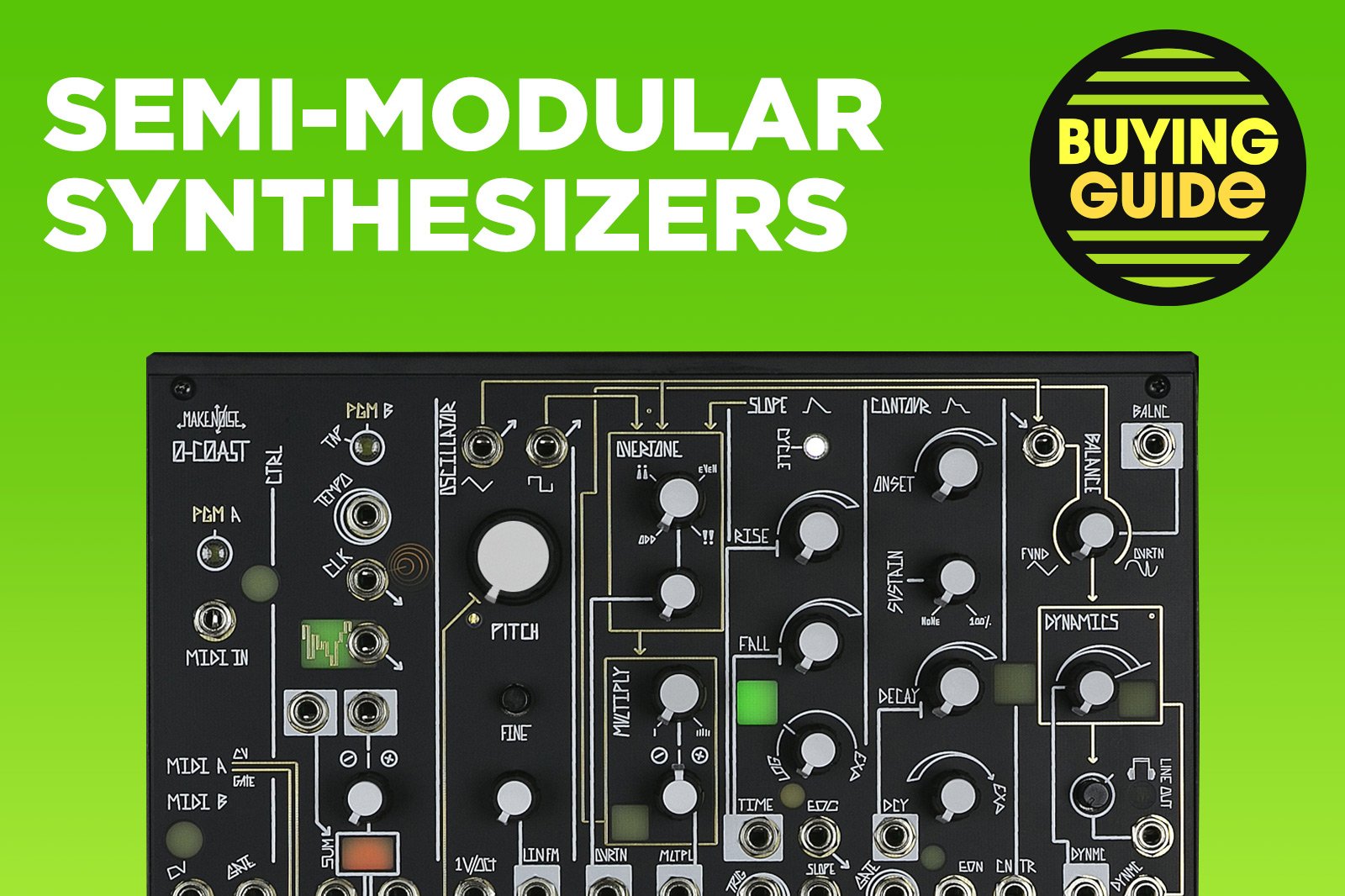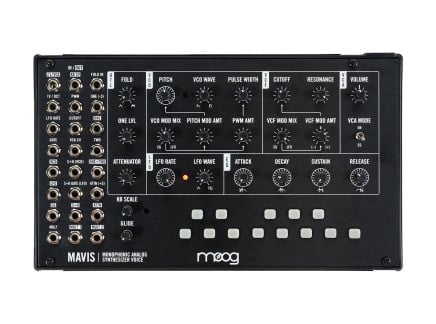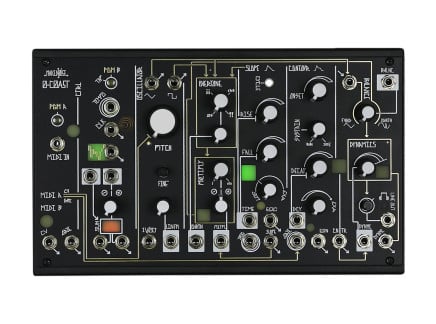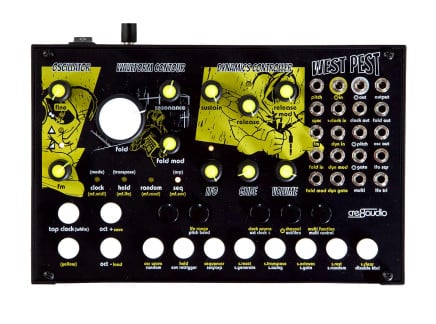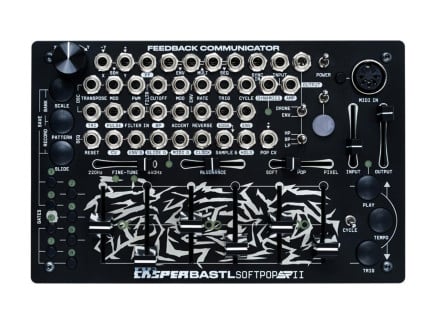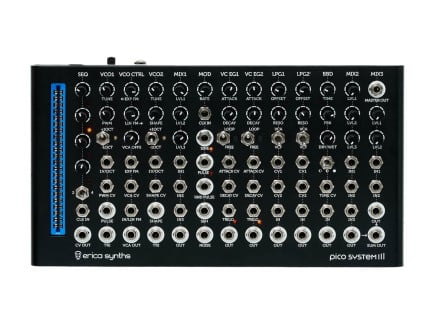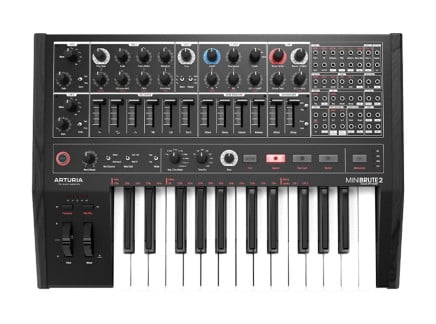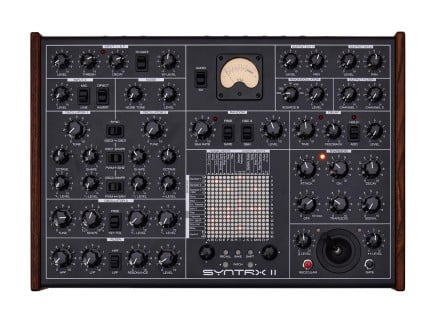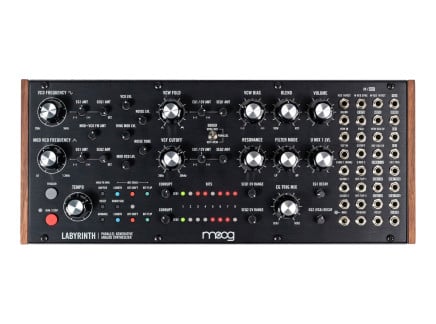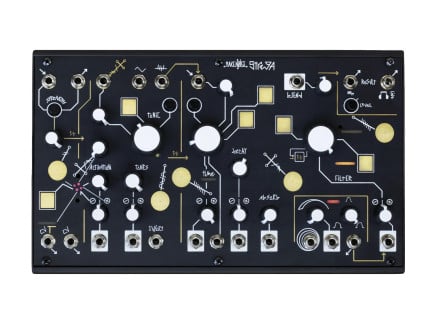We often hear from folks who are eager to get into modular synthesis, but for one reason or another feel like they can't. There are a lot of reasons: for some, a Eurorack system is out of their budget (quite understandable), and for others, the workflow of modular synthesis is so foreign that it comes across as intimidating (also quite understandable). As such, it can be a difficult world to break into. However, there are a lot of ways to circumvent these issues. One of the most time-tested solutions is to look toward semi-modular synthesizers, which present an interesting solution to each of these problems.
If you're new to this world, you might be wondering...what is a semi-modular synthesizer? For the sake of this article, we'll use this definition: a semi-modular synthesizer is self-contained patchable synthesizer with a selection of internal functions (modules) curated by its designer, all behind a single panel; usually, semi-modular synthesizers feature a partly-predefined (normalled) signal path that can be over-ridden through the use of patch cables. This differs from typical modular synthesizers, in which it's usually up to the user to select and configure the modules that best suit their own purposes. Additionally, "fully" modular synths typically require a significant amount of inter-module patching in order to get to your desired sonic results. In that way, they can be a bit more complex to use than their semi-modular counterparts.
In the past several years, the semi-modular "concept" has been put to use by many manufacturers in order to create instruments that are accessible to beginners, both in terms of budget and in terms of ease-of-use...but that's not to say that they're only for beginners. In fact, many semi-modular synths available today are quite powerful, inspiring, and just plain fun regardless your level of experience. In this article, we're going to look at our top recommendations for instruments in this category: relatively affordable (yet quite capable) semi-modular synthesizers that we think could make a great first step into the weird world of patchable analog synths. Let's get started.
Starting Small: Moog Mavis
Moog has been crafting exceptional synthesizers for decades, so it should be no surprise that they have recently excelled at creating Eurorack-compatible semi-modular synthesizers. In the past several years, their Mother-32, DFAM, Subharmonicon, and Labyrinth have become modern classics, starting many musicians' journeys into the wide world of modular synthesis. However, earlier this year, a new member of the Moog semi-modular family emerged…one about which we're particularly excited.
Earlier this year, Moog released their compact Mavis desktop semi-modular synth, which offers a budget-friendly way to dip into modular without compromising features or sound quality. It's a perfect device if you are interested in the modular world and want to make sure you're getting a great value and a well-rounded instrument while keeping cost at a minimum.
Mavis is a no-nonsense synthesizer that follows many conventions of Moog synthesizers of the past. The signal path starts with a rich oscillator capable of producing a continuous blend of saw and pulse shapes, complete with the option for pulse-width modulation. The signal then passes into a classic Moog 24dB/octave transistor ladder lowpass filter, complete with resonance well into self-oscillation. The audio path ends with a VCA, which can be set to drone or to be influenced by the built-in ADSR envelope. The unit additionally features a patchable wavefolder, great for adding extra sonic interest, a one-octave keyboard (with scaleable pitch range), and an LFO with variable waveshape and optional voltage control (at roughly 1V/octave). Mavis has everything you need to start making sound and playing everything from classic Moog tones to insane sound effects and more.
While not as robust as the larger Moog semi-modular synths, Mavis has a very useful patch bay that can be used to create unique sounds—and if you decide to expand your setup, the patch bay's additional utilities will prove to be quite helpful. Mavis patched together with other modular or semi-modular gear and turned into a very capable modulation zone. Mavis is actually quite a formidable synthesis tool, with the VCO able to go low enough to create a steady rhythmic pulse, the LFO capable of having its Rate controlled via CV, and a sample & hold section that lets you patch your own external sources. A CV/audio mixer, a simple attenuator that shoots out +5v when nothing is patched, and a 1-to-2 multiple section are all patch-savers when you need them. And happily, many of these utilities are open-ended enough to serve multiple purposes…so with some creative patching, Mavis can do much more than might immediately seem possible.
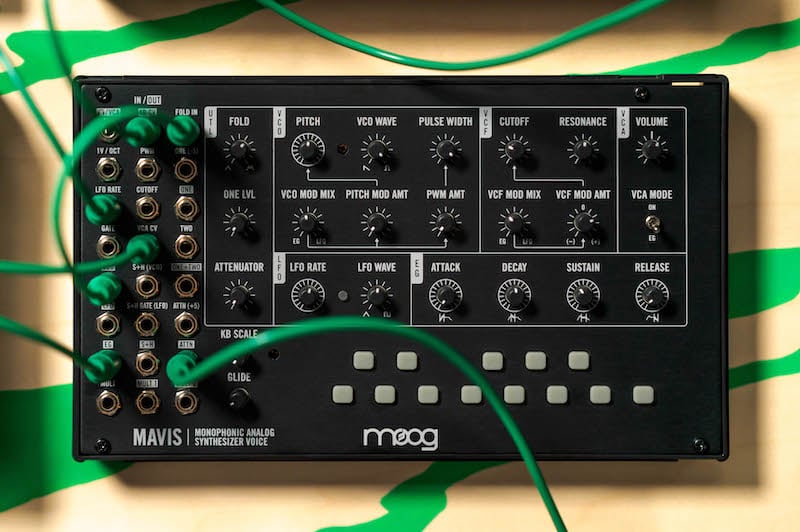
If you choose to eventually move on to building a Eurorack modular synth, you can also keep Mavis as a fairly compact main voice for your system—Mavis can be removed from its housing and placed in a Eurorack case (at only 44hp wide). It's important to consider that Mavis is not inherently MIDI-capable, and truthfully, adding an external sequencer or keyboard, some effects, or additional modulation sources will go a long way in turning this little friend into an even richer-sounding synth. The beauty of starting with something like the Mavis is that you can really get a sense of how you want to personally interact with synthesizers. Mavis ships as an easy-to-assemble kit, which also helps build a physical connection to the instrument and also makes electronics feel more accessible altogether.
And of course, as stated above, Mavis isn't Moog's only semi-modular synth: the Mother-32, Subharmonicon, DFAM, and Labyrinth could all be great next steps for synthesists starting out with Mavis. If you're curious to learn more about these synths or to compare their various strengths, we recommend checking out this article comparing all members of Moog's current semi-modular lineup.
Two Coasts Combined: Make Noise 0-Coast
Introduced in 2016, 0-Coast was the first standalone desktop instrument offered by Make Noise, succinctly capturing the spirit of much of their product line up until that point. With sections of the instrument informed by circuits from essential modules like Maths, STO, and Wogglebug, 0-Coast is often viewed as a sneak peek into the brand's sonic microcosm, and in some cases a full-on ramp into Eurorack. It certainly is both of these things, and also quite a bit more.
The underlying theme behind 0-Coast is about blurring the lines between so-called "East Coast" and "West Coast" schools of synthesis (more on this somewhat controversial topic here). The timing for its original release couldn't have been better, as discussion regarding the two paradigms was picking up considerably amidst the global revival of modular synthesis. And coming from a company that earned a growing base of dedicated followers by pursuing bold, predominantly "West Coast"-inclined synthesizer designs, this was particularly interesting. Make Noise, however, didn't choose an obvious path for bridging two schools of thought. In particular, the solution wasn't to stick a wavefolder into an otherwise subtractive synth, nor to endow a wavefolder-laden synth with a ladder filter. The company found a very different approach, which resulted in an exceptional synthesizer with an unmistakable character. Let's take a look at the architecture of the instrument.
0-Coast is a patchable synthesizer comprised of a unique collection of modules. It consists of eight sections: a MIDI interface with a built-in arpeggiator, a Clock/Random Voltage Generator, a Mixer/Mult/Polarizer, a triangle-core Oscillator with an additional square output, a Waveshaper (Overtone and Multiply), a Serge-inspired 2-stage envelope called Slope which features a changeable curve shape (which can loop up into audio rates), a 4-stage envelope generator called Contour, and a VCA/Output (Dynamics). As mentioned earlier, 0-Coast is unique in that it does not have a filter. So, how is this an even representation of each sonic "Coast"?
In so-called West coast synthesis, complex sounds are created by distorting simple waveforms. In the case of 0-Coast, both triangle and square waves are combined within the waveshaping Overtone circuit, and the effect can be further intensified by the Multiply. The Overtone and Multiply circuits make up the essence of the distinct sound of the instrument. And because they can be pushed to the edge, where the abundance of overtones overshadows the fundamental frequency, the Balance knob can be used to find the perfect mix of a clean triangle wave, and its distorted counterpart. The signal chain ends in a Low Pass Gate—a circuit typical of Buchla designs—but rather than being based on a vactrol, it's a transistor-based design, subtly departing from Buchla's world of sonic coloration.
East Coast concepts, on the other hand, manifest in the dynamical processing within the instrument—a classic Minimoog-style envelope and a dynamic output stage, along with its option for MIDI control. This blend makes the instrument wildly responsive to traditional keyboard playing, while simultaneously beaming with potential for experimental skronk.
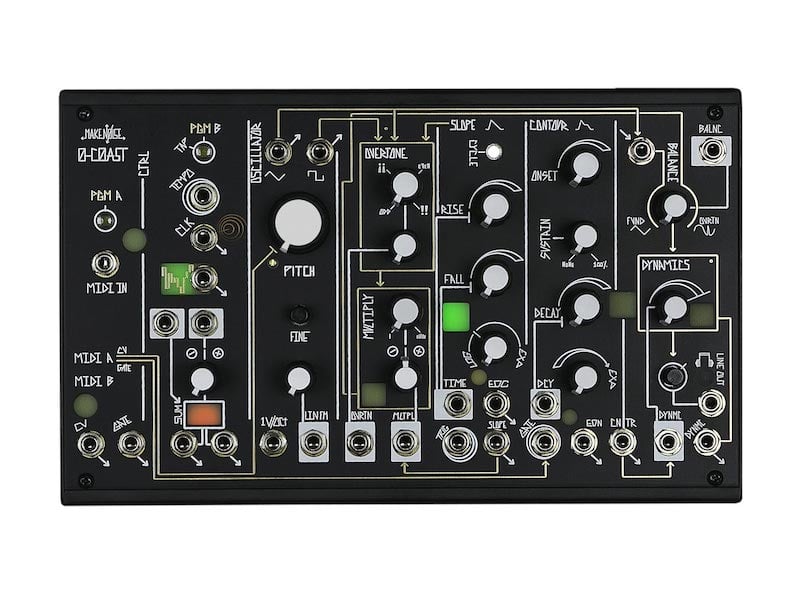
Of course, being semi-modular, most sections on the 0-Coast are in some way internally wired, and it can be played like a classic monosynth with just a MIDI keyboard or a sequencer added…no patch cables involved. For convenience, the graphics on the instrument's wild-looking interface feature gold arrow lines that conveniently trace the default routing. And once you are ready for deeper sonic quests, the internal normalled connections can be over-ridden through patching.
The combination of an intuitive interface, accessibility, easy interconnectedness with other equipment, and a plethora of advanced features certainly make 0-Coast a great synthesizer to start or continue your modular journey, but they also render it a very unique and capable instrument all on its own. It provides a clever sampling of ideas found in other modular instruments as well, making it a great stepping stone toward the world of Eurorack for those who are interested in going that direction.
Moreover, since the instrument's release Make Noise has brought into the world two more desktop instruments in the very same format as 0-Coast—an analog sequencer/touch plate keyboard called 0-CTRL, and a chaotic delay-based synthesizer made in partnership with Alessandro Cortini named Strega. Needless to say, all three instruments working together form a singular sonic ecosystem, and it is easily conceivable that someone may prefer a setup just like that. It's been said many times around Perfect Circuit that some of our staff members would be just as happy with a 0-Coast/0-Ctrl as they would be with a wall full of Eurorack modular gear.
A Taste of Both Coasts: Cre8audio's East Beast and West Pest
Modular synthesis may not be the cheapest hobby or musical tool around, but Cre8audio has been consistently working to lower the financial barrier into this special world of sound design and musical composition. Their Eurorack modules and cases are rather affordable as far as these things go, but their new line of semi-modular instruments brings things down to a price point relatively untouched at this point. Indeed, their two semi-modular devices, the East Beast and the West Pest, are the most affordable items on this list, and respectively touch upon two of the most prevalent paradigms of synthesis.
It's also worth noting that these lil' synths were designed in collaboration with Eurorack veterans Pittsburgh Modular, who have long been one of our favorite designers of both solid and straightforward modules as well as far-out, one-of-a-kind instruments. Both East Beast and West Pest see the marriage of Pittsburgh's analog expertise with Cre8audio's clever digital control and interfacing. The result is a pair of instruments that deliver the best of both worlds, and either one could drop into any studio as a delightful addition to any musical workflow.
East Beast, as implied by its name, is a synthesizer which draws from the lineage of so-called East Coast synthesis. This is an architecture pioneered by Bob Moog's designs, which single-handedly shaped the greater synthesizer industry as we know it today. Inside the East Beast you'll find the quintessential analog components of what made instruments like the Minimoog so desirable: a solid oscillator, a rich filter, and an ADSR-style envelope generator. This is also known as subtractive synthesis, wherein the rich harmonics of an oscillator and carved away by a filter, and further shaped by envelopes and LFOs. Immediately accessible and generating the sounds we all associate with synthesizers, the East Beast is instantly musical and a whole lot of fun.
Should you crave a more experimental approach, West Pest similarly draws from the heritage of so-called West Coast synthesis. Relatively less talked about until the rising popularity of Eurorack manufacturers like Make Noise, West Coast synthesis primarily refers to design philosophies found in Don Buchla's instruments, such as the Music Easel and 200 Series of modular synthesizers. Just like the East Beast, sounds begin with an oscillator, but are instead shaped by a wavefolder and dynamics controller, the latter of which is inspired by vactrol-based lowpass gates that act like both a VCA and mild filter at once. Even with its synthetic sound qualities, this gives West Pest similarities to the behavior of acoustic instruments, which tend to exhibit brighter timbres when hit, plucked, or struck that then mellow out as they fade to silence.
Both the East Beast and West Pest offer a dual-function button keyboard that can be used to play sounds or configure aspects of their digital behavior. From the internal sequencer to a variety of modulation sources, both instruments offer plenty of options beneath the panel controls. Whether you're looking for the most budget-friendly option or something highly configurable to play along with your DAW and other hardware pieces, giving these semi-modular synths from Cre8audio a shot may very well be worth your time.
Outer Space Coast: Bastl SoftPop 2
A lovechild of the iconic circuit-bender Pete Edwards/Casper Electronics, and Bastl Instruments's chief synth maker Václav Peloušek, SoftPop 2 is a semi-modular synthesizer unlike any other. In its second incarnation, SoftPop retains a quirky character. Its performance-friendly interface has earned the original a cult status in the community—and while man aspects of the original design also remain intact, it has also been significantly upgraded in many aspects. The most notable change is the replacement of the jumper cable patch bay with a more reliable 3.5mm patch bay, the addition of a powerful sequencer, MIDI input, and a number of other things. But before we get into the nitty-gritty details of this tricked-out instrument, let's start with what SoftPop is.
Essentially, the identity of SoftPop lives somewhere between chaotic squeals of Rob Hordijk's synthesizers, and acidic sequences reminiscent of Roland TB-303. This is not a coincidence, since Pete Edwards earlier work with DIY and circuit-bent instruments were often inspired by Hordijk's "bent by design" instruments like the Blippoo Box and Benjolin. The core of SoftPop is an analog modular synthesizer complete with an oscillator, a characterful filter, an envelope, and Sample and Hold circuits. The second part of the SoftPop equation is the powerful digital sequencer. This coupling is what Bastl refers to as "analog heart, digital brain" architecture, and this combo works marvelously.
While a well-curated amalgamation of modules and an open patching system already make for a great synthesizer, what truly makes SoftPop standout as a musical instrument is how these elements are configured to interact, as well as how this interaction is managed by the performer—the interface. Quite unexpectedly, despite the open-ended patch bay, a source of magic can be found in how the elements of the synthesizer relate to each other in the instrument's default state. The normalled routing of the instrument is a hybrid of a standard subtractive synth patch and feedback techniques. The oscillator's pulse waveform passes through a resonant filter to a VCA to an output. The triangle wave of the oscillator is passed to the Sample and Hold, and its output in turn modulate's the oscillator's pitch at the rate established by the same envelope that shapes the dynamic and timbral contours of the sound. Right off the bat, without any patching, the instrument clearly invites the user to explore unfamiliar sonic terrains, and creatively engage with feedback and chaos.
It is also evident that it was important for the designers to make the instrument performable, and more so, suitable for a variety of musical contexts. This is accommodated through a set of controls ergonomically positioned to always be within reach: a dedicated envelope trigger button, drone or envelope mode switch, envelope self-cycling switch, mod faders assigned to crucial parameters, a built-in quantizer, and a robust sequencer with advanced features like slides, play orders, trigger effects, and pattern chaining.
On top of that, just like the original SoftPop, version two can act as a very capable sound processor with a range of effects extending from auto-wah quacks to unruly bitcrushing. And because of the instrument's expansive modulation options, the effects are not static, but rather dynamically responsive. This makes SoftPop a particularly suitable companion for drum machines and grooveboxes.
The versatility of SoftPop is mindboggling. It is really impressive how Bastl and Casper managed to create an instrument that excels in so many different areas. In a single gesture, one can move from a sound resembling Drexciya's bassline to something closer to Morton Subotnick's plucky sonic expeditions. It is one of those rare instruments that can be equally enjoyed by someone making dance music, a noise artist, an academic, or film composer.
West Coast Reimagined: Erica Pico System III
Erica Synths have produced their line of compact Pico modules for several years now, and along the way they've offered a couple of pre-configured systems of these modules for curious minds looking to get started with Eurorack. But numerous discrete modules will almost always be more expensive than a single unit, and without any advantages that come along with that, such as normalled between modules. So when Erica revealed the Pico System III a few years ago, we were stoked to see a collection of the best Pico circuits wrapped up into a consolidated semi-modular package—not to mention its attractive pricing that puts it below $600.
At first glance, it might seem like the Pico System III is just a bunch of their modules under one shared panel, but astute observers will notice these versions are a bit simpler than their standalone counterparts. Indeed, the streamlined controls certainly make the Pico System III feel a bit more approachable, and not nearly as crowded as it could have been with a 1:1 translation of the modules into this form. And with effectively 13 modules squeezed together, we think this was the right move.
Of all the options on our list, the Pico System III feels like it may be the most functionally stacked out of them all. Two oscillators, two envelopes, two LPGs, three mixers, modulation and sequencing, and a BBD delay gives you a lot to work with, and assembling this collection of tools with individual Eurorack modules would cost a significant amount more than the Pico System III. And even though we mentioned above that these Pico modules are fairly straightforward, the sheer amount of options that you have here means that you likely won't become bored with what can be achieved here—even if you decide to expand with more modules and synths in the future.
But what is possibly one of the most unique and interesting features of the Pico System III is the inclusion of a card slot on the left. Inspired by the classic Buchla Music Easel, the Pico System comes with a selection of preset cards, configured with internal routings that connect modules together without the use of patch cables! Of course, you can always extend or override the default connections of a card by patching in some cables, but the option to just swap in a totally different patch on the fly is rarely achieved with a modular synthesizer. Best of all, a handful of blank cards are included, meaning that if there's a patch that you consistently keep coming back to, you can easily bust out your soldering iron and create a "preset" that can be recalled anytime!
It's worth noting that Pico System III does require a bit more patching to get up and running than some of the other synths on this list; it doesn't present nearly as many internal normalled connections as, say, the 0-Coast. This in some ways contributes to its open-endedness, but it may not be quite as approachable for absolute newcomers. However, if you're looking for one of the most flexible semi-modular options around, or need the closest thing to a preset-laden synth with the flexibility and fun of physical patching, Erica's Pico System III just might be the perfect option for you. It's also worth mentioning that the Pico System III comes both in fully standalone and Eurorack-format packages, the latter of which could prove to be an excellent starting point for a Eurorack system if you know you're planning to head that direction with your setup.
Modern Classic: Arturia Minibrute 2
Before Eurorack became as popular as it is today, analog synthesizers were an even smaller niche that few manufacturers gave much thought to. Among the first manufacturers to recognize the growing public interest in analog instruments were software/virtual analog synth designers Arturia.
Arturia introduced the first iteration of the MiniBrute 10 years ago, and not only was it one of the first mass marketed analog synths in years—it also featured CV outputs for interfacing with Eurorack modules or the modular synth of your choosing. Several years later, they released a redesigned, more robust version of the MiniBrute, the MiniBrute 2. No simple redesign, this was a massive overhaul that added an extensive semi-modular patchbay that gives you direct access to the innards of the synth via a 48 points of connectivity. It also comes in at a very reasonable price and sounds great.
The MiniBrute 2 is a fully functional, self-contained instrument, acting like a more-or-less conventional subtractive synth by default, with tons of additional sonic potential opened up through patching. Of course, it has tons of unique tricks up its sleeve—a multi-waveform oscillator with special timbral modifications for each oscillator waveshape (ultrasaw, PWM, and "metalizer"), a beautiful Steiner-based filter design with Lowpass, Bandpass, Highpass, and Notch options, two LFOs with a wide range of shapes (including stepped shapes and smooth and stepped randomness), and a looping A/D envelope generator. There's much more to it than just that, of course—but hopefully that's enough to get your wheels turning.
Both the Minbrute 2 and Minibrute 2S are equally useful when starting to build a modular synth system, and with the semi-modular patch bay, expansion is simple and almost inevitable. Helpful utilities are often included on semi-modular systems, and the MiniBrute is no different with 3 LFOs, 2 EGs, VCA, inverter, and 2 attenuators. It will happen: you will have your Eurorack system and be just moments away from the perfect patch when suddenly you realize there's no way for you to invert a signal, or you ran out of LFOs/Envelopes, or if only you had but a single VCA this would be possible. We often don't think about these things until we need them and with either varietal of the MiniBrute, you're covered. Of course, you'll find that patching within the instrument itself can open up an enormous amount of sonic range—for everything from custom bass and lead tones all the way to generative, out-there soundscapes.
Aside from the CV options, the MiniBrute 2 is also a great-sounding synthesizer which can easily integrate into a larger system. Pair with the 3U or 6U RackBrute Eurorack case, which can lock into fittings on either model, giving you plenty of room for expansion. Create elaborate effects with looping/sampling modules and effects modules; or add intricate interwoven melodic lines with an additional voice or two and a secondary sequencer; or do it all! Because there is an ever-growing number of modules in many different sizes, this workflow is as customizable as you might need.
But That's Not All: The Wider World of Semi-Modular Synths
Of course, the instruments we've talked about so far in this article are our recommendations for folks using semi-modular synthesizers as a way of dipping their toes into the world of patchable synthesizers altogether. As such, these recommendations are colored by a few basic considerations—mostly regarding price and functional density (aka "bang-for-your-buck"). However, we don't want to leave you with the impression that semi-synths are always a gateway to buying a modular synth. Similarly, we don't want to leave you with the all-too-common impression that semi-modular synths are in some way conceptually inferior to "fully modular" synthesizers. So, let's take a quick look at some other excellent semi-modular instruments that we love, but were otherwise left out of this article simply based on their price.
Of course, if you're looking for the sounds of a vintage semi-modular device on the more aggressive end of the spectrum, Korg also produces the MS-20 Mini, a similarly scaled-down and MIDI-capable take on their own vintage semi-modular design. Praised for its edgy character, its powerful sounds, and its flexibility as a processor for external devices, the MS-20 Mini sounds just as mean as its original counterpart; but of course, it can always be dialed back for smooth leads and basses if needed. That said, you'll have a hard time resisting the temptation to patch it into a state of animated sonic mayhem.
Continuing the theme of updates to classic designs, Buchla USA produces the Easel Command—a slightly re-imagined take on Don Buchla's original 1970s Music Easel design. It maintains the same signal flow and general feature set from the original, including the 5-step sequencer, Complex Oscillator, Modulation Oscillator, dual Lo Pass Gate, spring reverb, quad random voltage source, and more. Like the MS-20 Mini, the Easel Command features a wealth of connectivity options absent from prior versions of the Easel, including MIDI input, and optional USB Host port, and Eurorack CV/Gate inputs for easy integration into even more modular setups than ever before. The current Easel Command offers extended signal routing functionality absent from the front panel of Don Buchla's design, including more CV inputs, additional audio outputs, and FM input for the modulation oscillator, and more.
Buchla USA have put considerable effort into bringing attention to some of Don Buchla's now decades-old designs, and along with the advent of Eurorack modular synthesis, these instruments are more visible and sought-after than ever before. As you've likely noticed throughout the course of this article, the Music Easel has become a source of inspiration for many modern designs—and if you're looking for something that's even closer to the original than, say, a 0-Coast, West Pest, or Pico System III, then Buchla USA's Easel Command is the closest thing you're likely to find...with additional bells and whistles that current musicians may find helpful for forcing it into their own habits and workflow.
Offering an even more significantly mutated version of a classic synth design, Erica's Syntrx II takes concepts from the British EMS VCS3 and Synthi and presents them in an entirely new light. Famed for sonic flavors and idiosyncrasies quite distinct from Moog or Buchla designs, these EMS synths have become highly desirable...and now Syntrx makes some of their concepts more accessible than ever. Following the success of their own original Syntrx, the Syntrx II is a slightly more streamlined design with additional functionality, but all of the same charm.
While the original VCS3 and Synthi's "patch routing" was handled via a pin matrix, in which users could place physical pins in an X/Y-output/input grid to make patch connections, the Syntrx replaces this structure with a virtual patch matrix, with patch routings represented by an 16x16 LED display on the front panel. This maintains the spirit of the original, while adding at least one significant convenience: patch memory. Syntrx II can store 254 patch routings (though, you should note that knob positions are not stored as part of a preset). Additionally, the matrix display can be used to edit an internal piano roll-like sequencer, great for adding even more animation to your patches.
Aside from that, the internal signal path is quite similar to the architecture of the aforementioned classic EMS synths: gnarly variable-shape oscillators, peculiar filters, "Trapezoid" generator, a joystick for performance control, and more. It adds a delay in place of the original spring reverb, and offers a host of MIDI and CV inputs for integrating into any workflow. Looking for a taste of a completely different style of synthesizer without sacrificing modern I/O and patch storage? Syntrx holds a distinct, peculiar, and quite rewarding place among all current synthesizers.
To round things out for now, we should briefly return our attention to Moog. Of course, we mentioned their Mavis above—but it's worth re-stating that their entire semi-modular lineup are excellent instruments capable of a wide range of tones. If you know you're looking to dive deeper into modular synthesis, we'd recommend taking a look at Mother-32, DFAM, and Subharmonicon as well. Each has their own strengths: Mother-32 is an amazing analog lead/bass machine, while DFAM offers a novel take on drum synthesis, and Subharmonicon provides experimental approaches to sequencing and harmony. If you're looking for a detailed breakdown of these instruments, we'd strongly recommend checking out our article Which Moog Semi-Modular Synth is Right for Me?, in which we detail the differences between them.
Beyond these desktop semi-modular devices, though, Moog also offers semi-modular instruments geared toward keyboardists: the Grandmother is a powerful semi-modular monosynth inspired by classic Moog modular designs, while the Matriarch provides up to four-voice paraphony, with a stereo filter and delay section that are to die for. If you're looking for an open-ended semi-modular instrument with a keyboard-centric focus, we can't recommend these highly enough.
The Takeaway
The takeaway? There are loads of semi-modular instruments out there. This article details some of our favorites here at Perfect Circuit. These instruments are all trusted, and we've seen countless musicians use them as their first step into a new world of music-making. Some of those folks go on to buy modular systems, others explore further in the semi-modular realm, and yet others simply form a strong bond with these instruments alone, turning them into powerful tools for personal expression. No matter which you might choose, we have no doubt that it'll give you a lot to explore—and if you approach it with an open mind, it might just flip your musical world upside-down.

